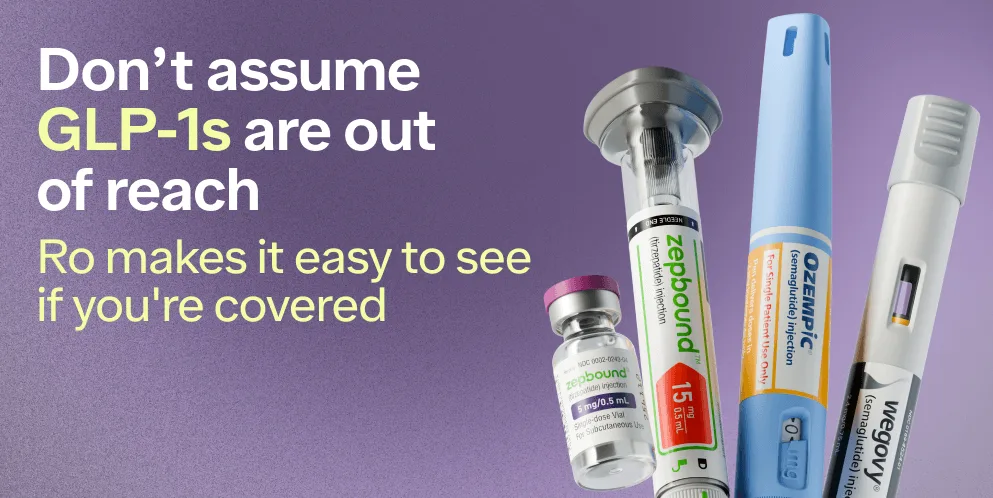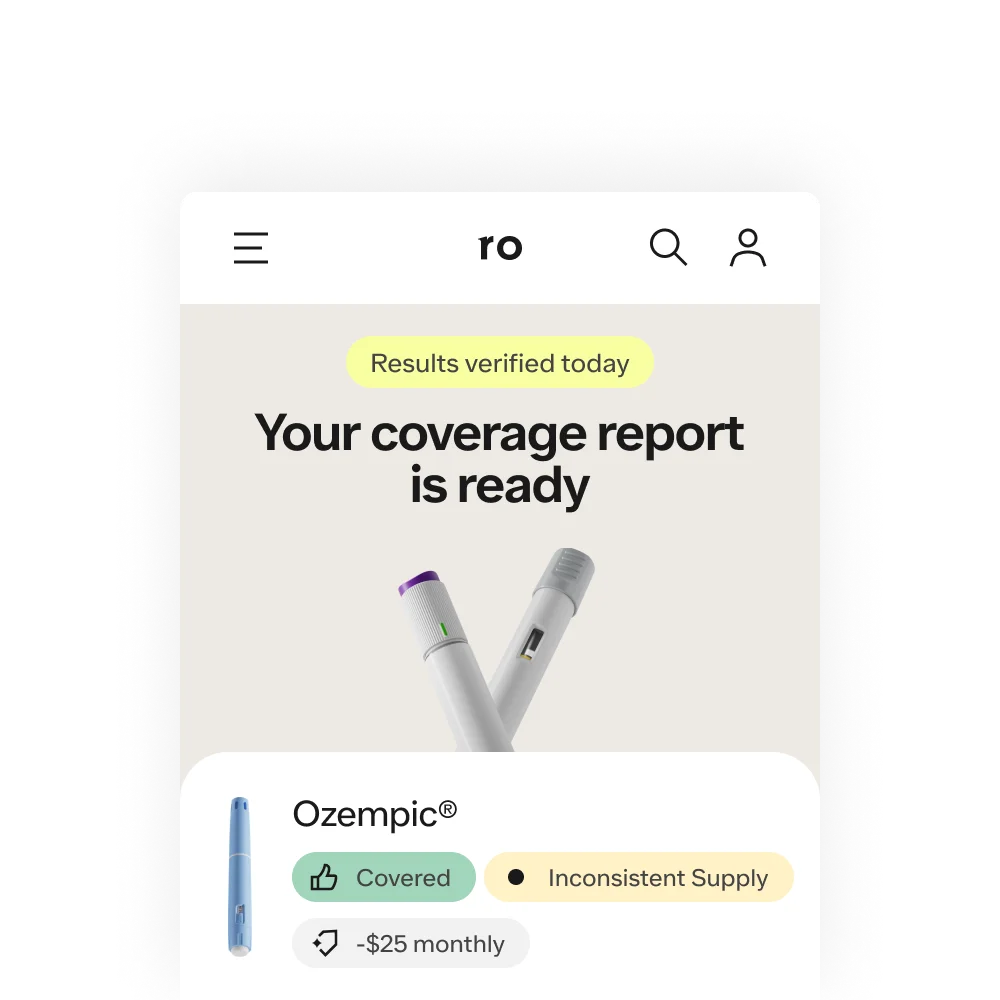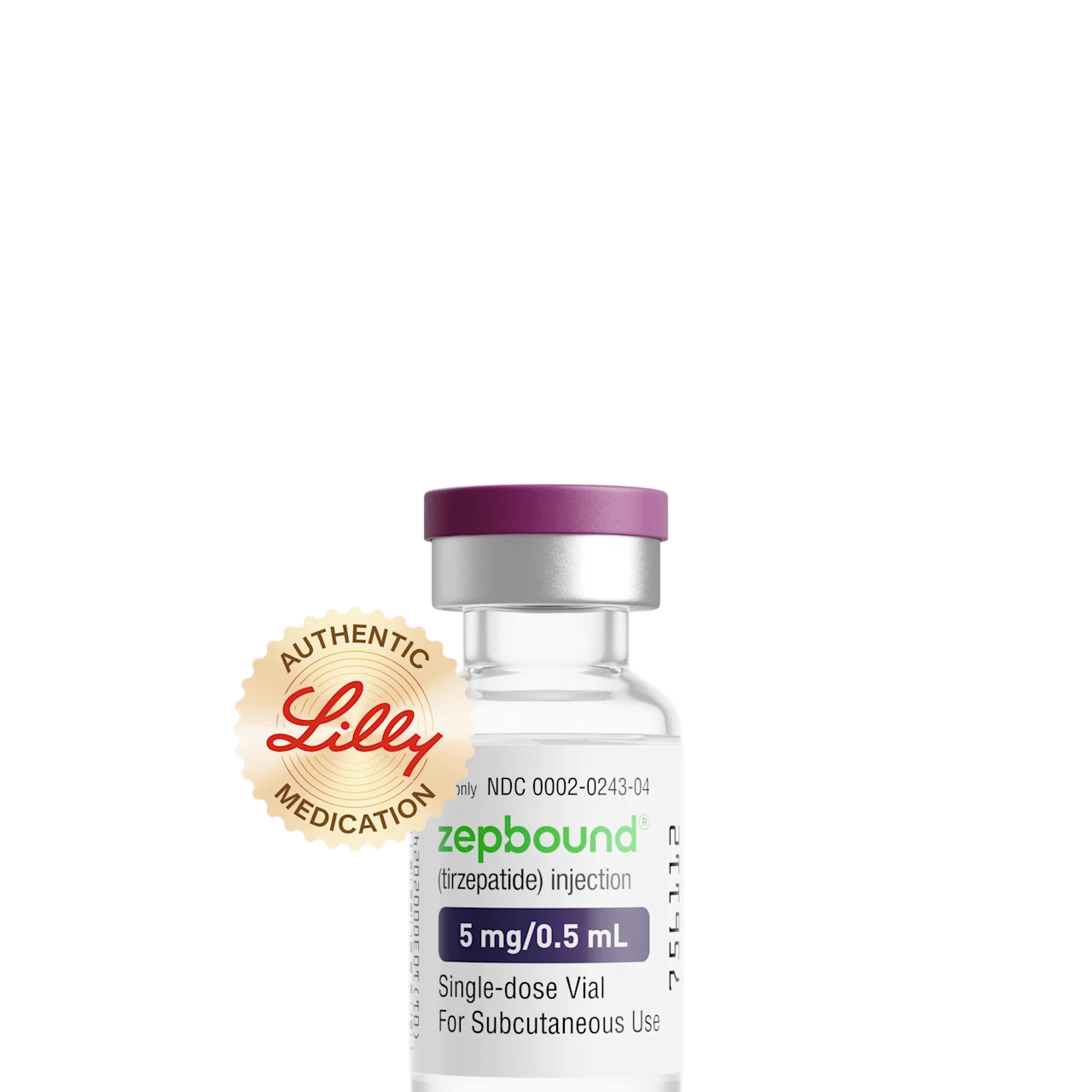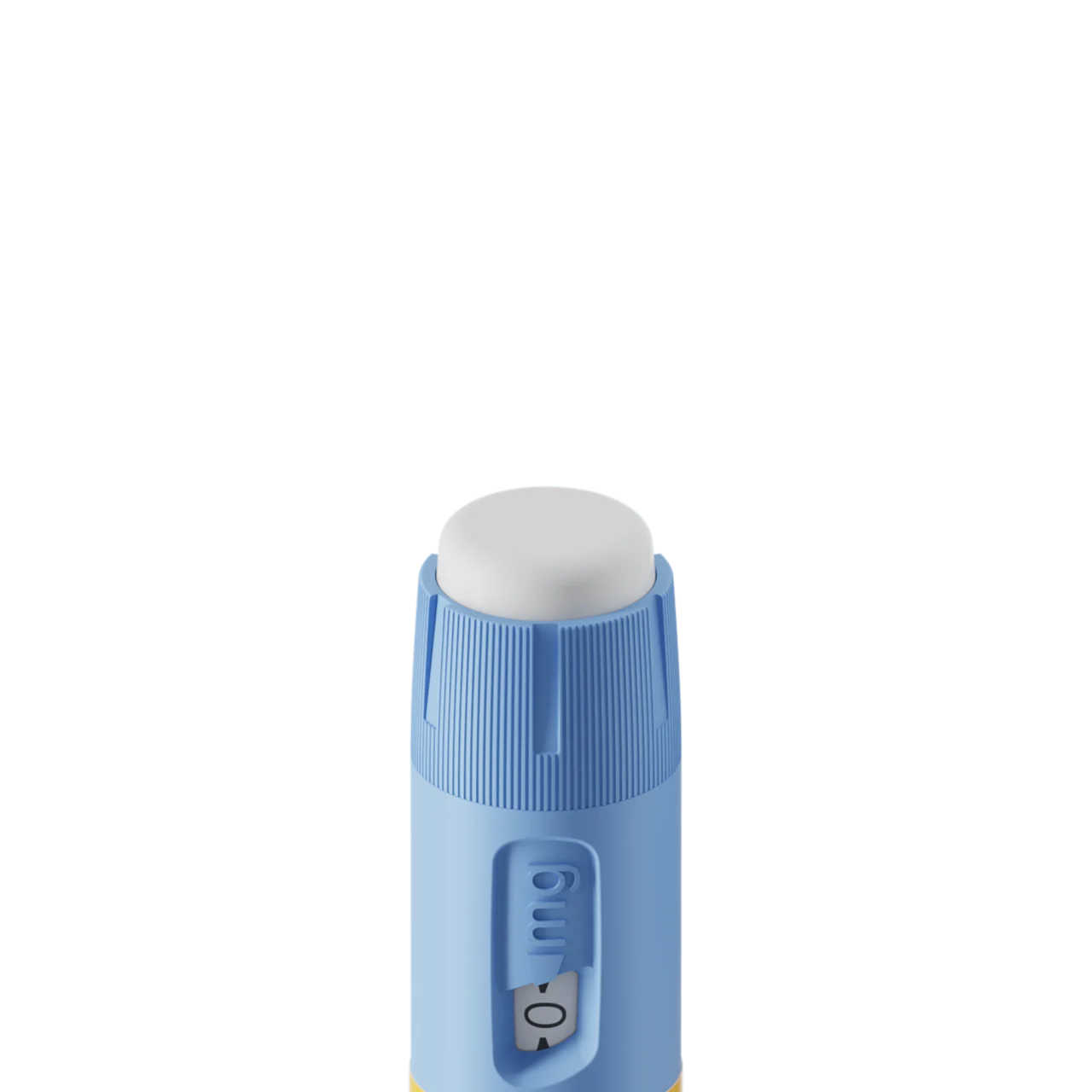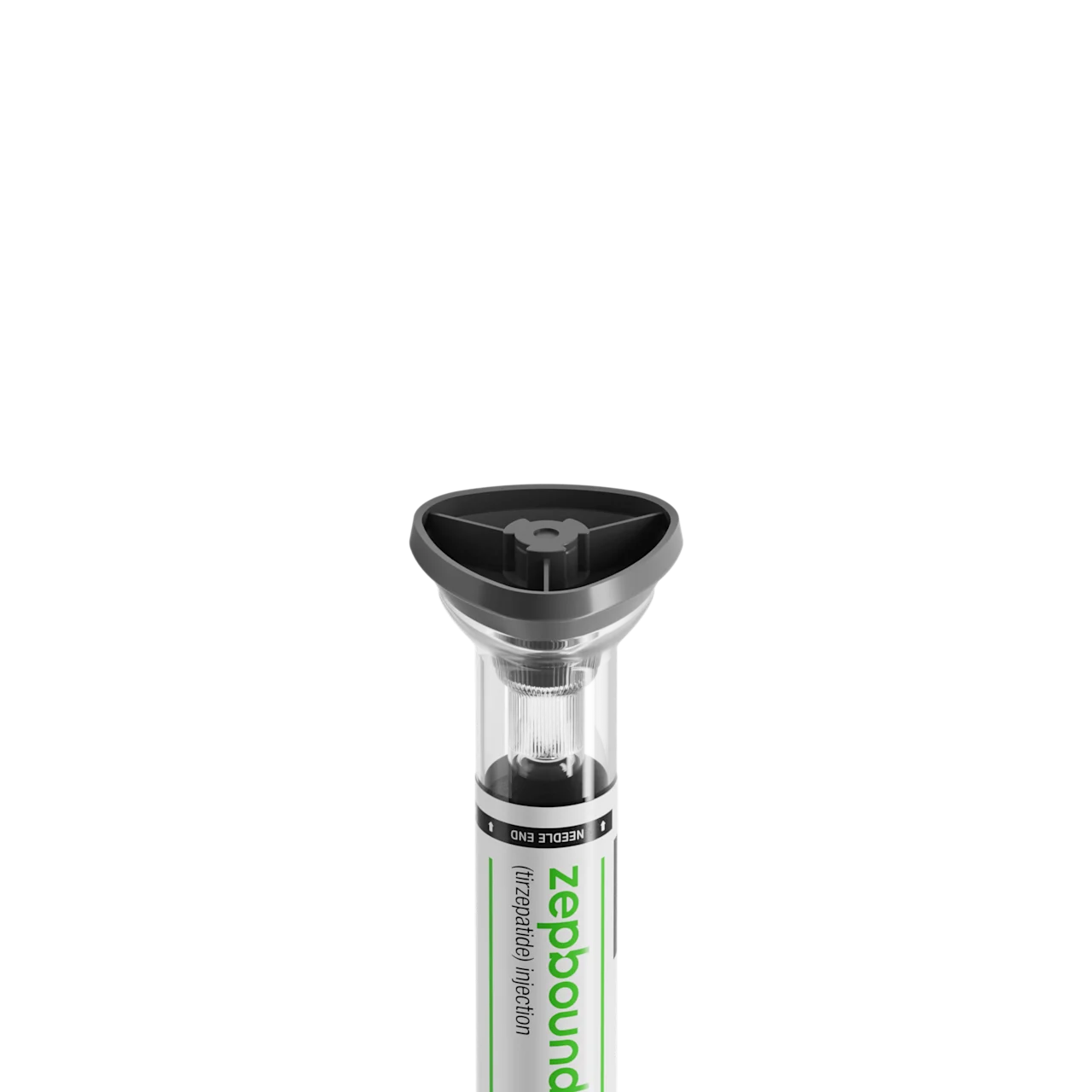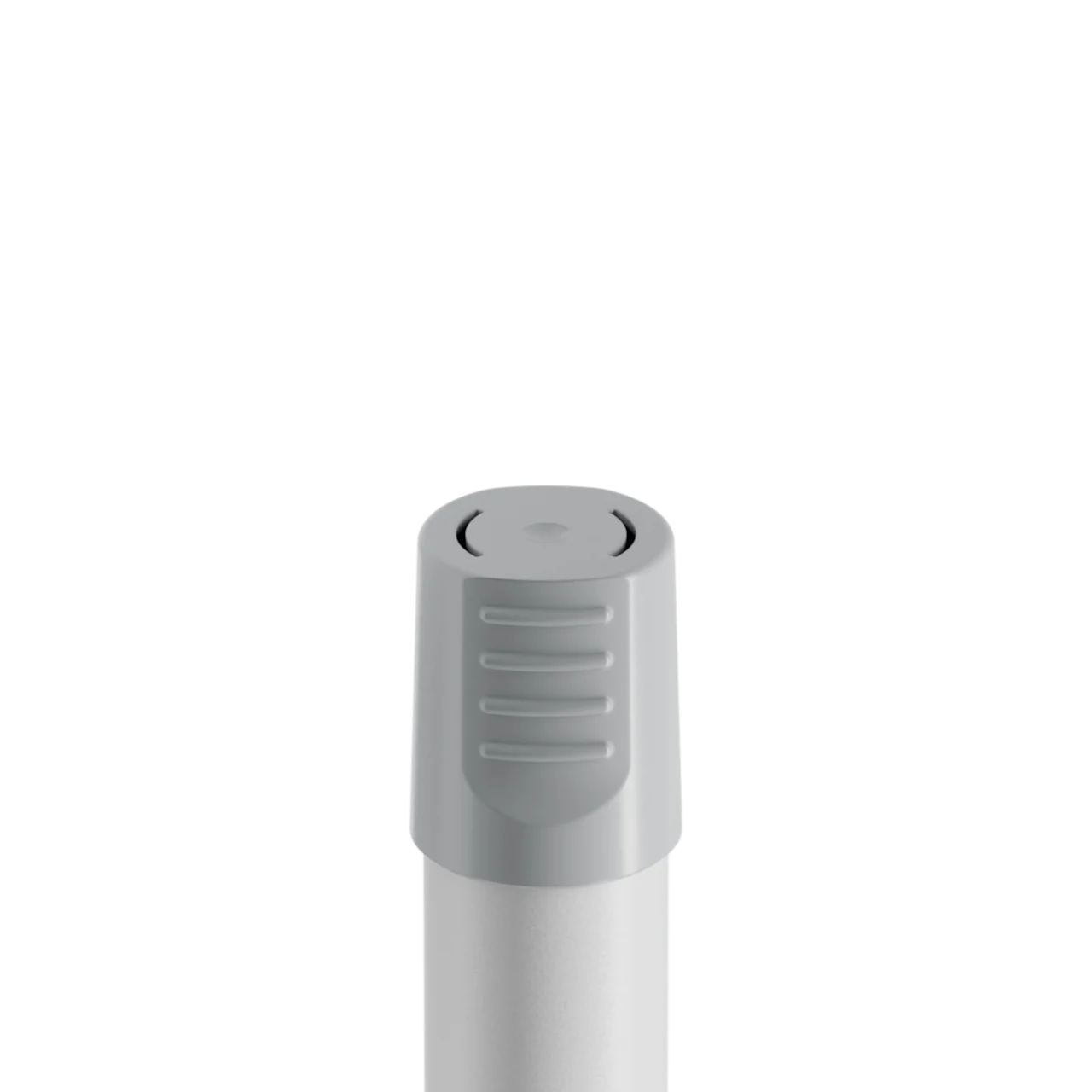Key takeaways
There’s no official Wegovy diet plan, but eating a reduced-calorie, nutrient-dense diet can help you lose more weight and minimize side effects.
Aim for a balanced diet of lean proteins (e.g. chicken, tofu), healthy fats (e.g. olive oil), fruits, vegetables, and whole grains (e.g. quinoa, brown rice).
Limiting fatty, sugary, salty, and highly processed foods can help Wegovy work better and make you feel your best.
Here's what we'll cover
Key takeaways
There’s no official Wegovy diet plan, but eating a reduced-calorie, nutrient-dense diet can help you lose more weight and minimize side effects.
Aim for a balanced diet of lean proteins (e.g. chicken, tofu), healthy fats (e.g. olive oil), fruits, vegetables, and whole grains (e.g. quinoa, brown rice).
Limiting fatty, sugary, salty, and highly processed foods can help Wegovy work better and make you feel your best.
When choosing what to eat on Wegovy (semaglutide), it’s all about finding foods that boost fullness, provide nutrients without too many calories, and minimize side effects.
So, what are the foods to eat and the foods to avoid when taking Wegovy? Here’s the kicker: There is no official Wegovy diet plan.
The only “official" recommendation is that the drug be taken along with a reduced-calorie diet. And for most people, this typically involves consuming 500–750 fewer calories per day. It’s best to check with your healthcare provider or dietitian to find the optimal caloric intake for you on Wegovy.
With those guidelines in mind, let’s dig in (pun intended) and discuss the foods to include (and to avoid) in your Wegovy diet plan.
What to eat on Wegovy
When you’re eating fewer calories, it’s especially important to prioritize nutrition from lean proteins, healthy fats, and whole carbs.
Here’s a breakdown of the key foods that should form the foundation of your Wegovy diet plan:
15%–25% lean proteins like turkey, tofu, lentils, and chicken
20%–35% healthy fats like avocados, olive oil, and fish
40%–65% whole carbohydrates like fruits, vegetables, and whole grains
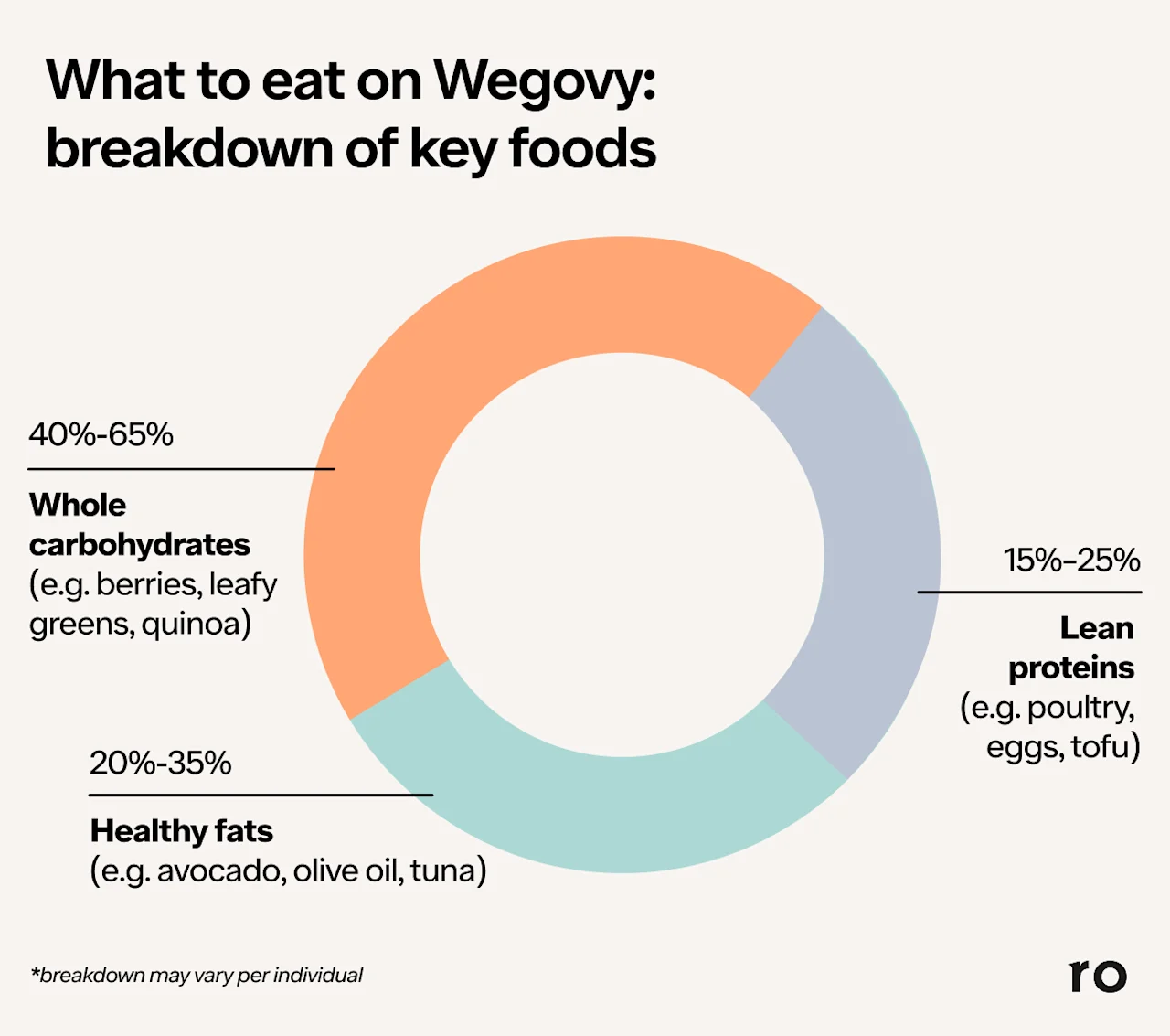
Fruits and vegetables
What to eat:
Berries
Apples
Pears
Citrus
Grapes
Bell peppers
Broccoli
Tomatoes
Peas
Carrots
Squashes
Leafy greens, such as spinach and kale
How much to eat: 1.5–2 cups of fruit and 2–3 cups of vegetables per day, according to the US Department of Agriculture (USDA) Dietary Guidelines for Americans.
Fruits and veggies fall into the carbohydrate category, so they — plus whole grains — should make up 40%–65% of your total daily calories.
Why you should eat: Fruits and vegetables are packed with important vitamins, minerals, and fiber.
Fiber can keep you feeling fuller longer, so it’s easier to manage your appetite and cravings on Wegovy. A small study of 17 male participants showed that eating fruit, such as an apple, before a meal can reduce caloric intake by 18.5%.
You may have heard that fruit has been deemed “bad” for weight loss because of its naturally occurring sugars. But a 2016 review found that including fruits (namely, whole, fresh fruits) in a balanced diet can support weight loss and healthy weight maintenance.
Nutritious, fiber-rich fruits and vegetables can also help stabilize blood sugar by slowing digestion and the absorption of sugar into the bloodstream. This can reduce the likelihood of overeating and snacking between meals, helping you maintain a calorie deficit for weight loss.
Try to consume mostly fresh or frozen fruits and vegetables, as they typically contain the most nutrients. However, canned and dried varieties can also be part of a healthy diet. Just make sure they do not have any added sugars, sodium, or unhealthy fats.
Lean proteins
What to eat:
Skinless chicken
Turkey
Tofu
Eggs
Beans, peas, and lentils
Seafood (e.g. tuna, shrimp)
Low-fat dairy products (e.g. cottage cheese, Greek yogurt)
How much to eat: The amount of protein to eat per day can vary from person to person, as it depends on your activity levels, age, and body weight. Some estimates indicate that adults need at least 0.8 grams of protein per kilogram of body weight (0.36 grams per pound) daily.
For Wegovy diets specifically, protein should represent 15%–25% of your total daily calories.
Find your recommended protein intake
Calculate your recommended daily protein needs for weight loss, maintaining weight, or building muscle, based on your current weight and activity level.
Recommended protein intake
0 – 0
Grams/Day
0 – 0
Grams/Meal
This calculator provides general estimates and should not replace professional medical advice. Always consult a healthcare provider or registered dietitian before making significant changes to your diet or nutrition plan.
Why you should eat: Eating adequate protein is crucial for maintaining muscle mass, which can be tough to do when losing weight. Plus, preserving muscle mass helps keep your basal metabolic rate up. That means you burn more calories — even when you’re not working out.
Lean proteins are also helpful for boosting satiety or fullness. They can keep you satisfied longer after eating. This may help reduce cravings and help you maintain a reduced-calorie diet.
Whole grains
What to eat:
Quinoa
Brown rice
Oats
Whole-wheat bread, cereal, or pasta
Barley
Rye
How much to eat: Adults should aim to eat approximately 3-5 servings of whole grains per day. As a carbohydrate, whole grains (along with fruits and veggies) should represent 40%–65% of your total daily calories on Wegovy.
Why you should eat: Rich in complex carbohydrates and fiber, whole grains take longer for the body to digest. That means they help you feel fuller, so you’re less likely to crave a snack. At the same time, they keep your energy levels up throughout the day, so you can stay more active.
Whole grains can also provide essential vitamins and minerals, such as the B vitamins thiamine, riboflavin, and niacin — all of which play a key role in metabolism.
Plus, a small 2017 study found that eating whole grains can speed up metabolism in some populations, which can help promote weight loss.
Healthy fats
What to eat:
Fatty fish (e.g.salmon, tuna, sardines)
Vegetable oils, including olive oil, avocado oil, and canola oil
Nuts and seeds
How much to eat: Adults should aim to eat 3/4 cup of healthy fats per day. Fats should represent 20%–35% of your total daily calories on Wegovy.
Why you should eat: Though it may be tempting to avoid all fats when on Wegovy, “healthy” (unsaturated) fats are an important part of a balanced diet.
Your body needs healthy fats for energy, optimal brain function, hormone regulation, and to help absorb vitamins from other foods you eat.
Ensuring each meal contains some healthy fats can also help you feel more satisfied after eating. This can help to reduce cravings later on in the day and, as a result, your overall calorie intake.
Foods to avoid on Wegovy
No one food is entirely off-limits on Wegovy. But you may want to limit your intake of certain ones, such as foods high in saturated fats, refined sugars, and refined carbohydrates.
Doing so may help reduce uncomfortable gastrointestinal (GI) side effects, such as diarrhea, nausea, and vomiting. Plus, these foods can often lead to overeating due to their low satiety and high-calorie content.
By reducing your intake and opting for nutrient-dense alternatives, you can better control your calorie intake. This, in turn, can make reaching and sustaining your weight loss goals easier.
Foods high in saturated fats
What to avoid:
Fried foods
Fast foods
Red and processed meats
Full-fat dairy products (e.g. butter, whole milk, cream cheese)
Shortening
Processed snacks
Why you should avoid: Foods high in saturated fats, such as fatty meats, full-fat dairy products, and processed snacks, tend to be high in calories. So, they’re not the best idea when you’re trying to eat fewer calories and lose weight.
On their own, fatty foods can also cause GI discomfort. Add Wegovy into the mix, whose common side effects are gastro-related (e.g. vomiting, diarrhea, nausea), and you may feel even worse.
It’s also worth noting that saturated fats are known to raise LDL ("bad") cholesterol levels, which can increase the risk of heart disease. Limiting saturated fat intake is essential to support the cardiovascular benefits of Wegovy — which is especially key if you’re taking it to treat heart disease.
Refined carbohydrates
What to avoid:
Processed foods
Pastries
Bagels
White bread, flour, rice
Crackers
Added sugars
Why you should avoid: Refined carbohydrates, such as white rice, sugar-sweetened breakfast cereal, and white bread, can cause blood sugar to rise and fall more quickly. Plus, they’re often low in fiber and other essential nutrients.
Translation: They can lead to more cravings and increased hunger. And these effects can potentially counteract Wegovy’s appetite-suppressing effects.
Aim to replace refined carbs with whole grains and legumes, such as brown rice, beans, high-fiber/low-sugar cereal, whole-wheat bread, and whole-wheat pasta.
Sugary foods and beverages
What to avoid:
Candy
Soda
Pastries
Dessert
Heavy syrups (such as those in canned fruit, coffee beverages, and cocktails)
Why you should avoid: Foods and beverages with added sugar tend to be high in empty calories with little-to-no nutritional value.
Like processed foods (which often contain added sugar), they can also cause a rapid rise in blood sugar levels. Blood sugar spikes can mess with weight loss as well as Wegovy’s beneficial cardiovascular effects.
Ultra-processed, sugary foods and beverages can also trigger or worsen common digestive side effects of Wegovy, including diarrhea.
In addition to pure sugar, keep an eye out for foods with artificial sweeteners like sorbitol, xylitol, maltitol, and mannitol. These can worsen side effects of Wegovy like diarrhea.
While occasional treats are okay, a Wegovy diet plan should focus on whole, unprocessed foods and minimize intake of sugary drinks and processed snacks.
High-sodium foods
What to avoid:
Chips
Canned soups
Cold cuts
Fast food
Fried food
Pizza
Why you should avoid: High-sodium foods can contribute to water retention and interfere with efficient digestion.
Wegovy in and of itself can also slow digestion. Combining it with high-sodium foods can cause or exacerbate common side effects, such as bloating and abdominal discomfort.
In the long term, excessive sodium intake can lead to high blood pressure and increase the risk of heart disease, stroke, and obesity.
Sample Wegovy diet plan
Here’s a sample 1-day Wegovy diet plan based on the information covered thus far and recommendations from the USDA and Centers for Disease Control and Prevention (CDC).
Breakfast:
1 cup of oatmeal topped with ½ cup of berries and 1 tbsp of chia seeds
1 hard-boiled egg
1 banana
The oatmeal, chia, berries, and banana can provide fiber, while the egg can offer a nice dose of protein. Altogether, you should feel filled up and ready to face the day.
If you start experiencing diarrhea on Wegovy, it’s a good idea to skip the berries and chia until it resolves.
Lunch:
2–3 ounces of turkey topped with slices of avocado, ½ cup of spinach, and sliced tomato
Apple
Eating the apple before the meal can reduce caloric intake by nearly 20%, ease nausea, and give you some fiber, along with the spinach and avocado.
The turkey can help you meet your daily protein needs, keeping your metabolism working its best and supporting muscle growth and maintenance.
Dinner:
1 cup of cooked quinoa or brown rice topped with 2–3 ounces of baked tofu or salmon
1 cup of steamed broccoli
The fibrous quinoa and broccoli can boost fullness so you can avoid late-night cravings. Meanwhile, the protein-rich tofu or salmon can further increase satiety and muscle health.
Snacks:
1 cup carrots with hummus
1 cup almonds or pistachios
1 cup low-fat cottage cheese or Greek yogurt
Nuts can be a fiber- and protein-rich snack when you start feeling peckish. For fiber, opt for carrots or another vegetable. If you want to boost your protein instead, opt for a cup of cottage cheese.
Rx weight loss with Ro
Get access to prescription weight loss medication online
Bottom line
While there’s no single Wegovy meal plan, most people can benefit from reducing their daily calorie intake by 500–750 calories and focusing on nutrient-rich foods that promote fullness and minimize side effects.
Prioritize lean protein. Foods like chicken, tofu, lentils, and fish support muscle health and improve satiety.
Include healthy fats. When eaten in moderation, avocados, nuts, and olive oil help you stay full and support heart and brain health.
Choose whole carbs. Fruits, vegetables, and whole grains provide lasting energy and fiber to aid digestion and keep you feeling full.
Limit processed foods. Avoid fatty, fried, sugary, and salty foods that can worsen nausea and disrupt weight loss.
Frequently asked questions
Whether you’re starting Wegovy or considering giving the medication a try, it's normal to have questions, especially regarding diet and lifestyle changes that can impact your ability to meet your weight loss and long-term health goals.
How much weight can you lose in a month with Wegovy?
How much weight you can lose in a month with Wegovy varies depending on your starting weight, medication dosage, diet, and physical activity levels. On average, people may lose about 2% of their body weight in the first month.
How much water should you drink while on Wegovy?
Experts recommend the average adult drinks about 8-10 glasses of water, or 2.2-3 liters, daily, though individual needs may vary. Adequate hydration can help manage appetite, support healthy digestion, and alleviate some Wegovy side effects.
How many daily calories should I eat on Wegovy?
How many daily calories you should consume on Wegovy depends on your weight loss goals, current weight, activity levels, health history, and other factors.
When taking Wegovy, experts generally recommend eating 500–750 fewer calories per day than your typical intake. In total, you may eat anywhere from 1,200 to 1,800 calories daily on Wegovy, depending on your body’s needs.
What happens if you eat sugar on Wegovy?
While the occasional sweet treat is okay on Wegovy, sugary foods can spike your blood sugar levels and cause cravings. They can also promote inflammation and increase the risk of cardiovascular disease. Plus, too much sugar can worsen Wegovy’s gastrointestinal side effects, such as diarrhea. Instead, opt for naturally sweet fruits or low-sugar alternatives when your sweet tooth strikes.
What happens if you eat fatty foods on Wegovy?
Fatty foods are not all created equal. For example, fried foods full of saturated fats, highly processed foods, and fatty meats can worsen gastrointestinal side effects like nausea, diarrhea, and vomiting on Wegovy. Instead, incorporate lean protein sources and small portions of healthy fats, such as avocados and nuts, into your Wegovy diet plan.
What is the best diet while on Wegovy?
There is no official Wegovy diet plan. The “best” diet while on Wegovy is one that includes:
Lean proteins, such as turkey, tofu, and skinless chicken
Fruits and vegetables
Whole grains, such as quinoa, oats, and whole-wheat bread
Healthy fats, such as avocados and olive oil.
Ideally, your Wegovy diet should also contain fewer calories — up to 500–750 fewer calories per day than your usual intake. However, it’s important to consult a healthcare professional, such as your provider or a registered dietitian, to determine the best diet and caloric guidelines for you.
How fast can you lose 20 pounds on Wegovy?
How fast you lose 20 pounds on Wegovy varies from person to person. But in clinical trials, people lost about 8% of their body weight in their first four months. If you weigh 250 pounds, that equates to 20 pounds in four months, though results can depend on your dose, diet, and activity level.
What breakfast to eat on Wegovy?
How to speed up weight loss on Wegovy?
To speed up weight loss on Wegovy, incorporate healthy lifestyle changes, such as:
Eating a nutritious, reduced-calorie diet
Increasing physical activity
Improving stress and sleep
DISCLAIMER
If you have any medical questions or concerns, please talk to your healthcare provider. The articles on Health Guide are underpinned by peer-reviewed research and information drawn from medical societies and governmental agencies. However, they are not a substitute for professional medical advice, diagnosis, or treatment.
Wegovy Important Safety Information: Read more about serious warnings and safety info.
References
Abdul Hakim, B. N., Yahya, H. M., Shahar, S., et al. (2019). Effect of sequence of fruit intake in a meal on satiety. International Journal of Environmental Research and Public Health, 16(22), 4464. doi: 10.3390/ijerph16224464. Retrieved from https://www.ncbi.nlm.nih.gov/pmc/articles/PMC6888291/
Ahmad, A., Isherwood, C., Umpleby, M., et al (2020). Effects of high and low sugar diets on cardiovascular disease risk factors. Journal of Nutritional Science and Vitaminology, 66(Supplement), S18–S24. doi: 10.3177/jnsv.66.S18. Retrieved from https://pubmed.ncbi.nlm.nih.gov/33612591/
Allison, A. & Fouladkhah, A. (2018). Adoptable Interventions, Human Health, and Food Safety Considerations for Reducing Sodium Content of Processed Food Products. Foods, 7(2), 16. doi: 10.3390/foods7020016. Retrieved from https://www.ncbi.nlm.nih.gov/pmc/articles/PMC5848120/
Bhupathiraju, S. N. & Hu, F. (2023). Carbohydrates, Proteins, and Fats. Merck Manual: Consumer Version. Retrieved from https://www.merckmanuals.com/home/disorders-of-nutrition/overview-of-nutrition/carbohydrates,-proteins,-and-fats
Bouzari, A., Holstege, D., & Barrett, D. M. (2015). Vitamin retention in eight fruits and vegetables: a comparison of refrigerated and frozen storage. Journal of Agricultural and Food Chemistry, 63(3), 957–962. doi: 10.1021/jf5058793. Retrieved from https://pubmed.ncbi.nlm.nih.gov/25526594/
Cava, E., Yeat, N. C., & Mittendorfer, B. (2017). Preserving Healthy Muscle during Weight Loss. Advances In Nutrition, 8(3), 511–519. doi: 10.3945/an.116.014506. Retrieved from https://www.ncbi.nlm.nih.gov/pmc/articles/PMC5421125/
Cena, H. & Calder, P. C. (2020). Defining a healthy diet: Evidence for the role of contemporary dietary patterns in health and disease. Nutrients, 12(2), 334. doi: 10.3390/nu12020334. Retrieved from https://www.ncbi.nlm.nih.gov/pmc/articles/PMC7071223/
Centers for Disease Control and Prevention (CDC-a). (2024). About sodium and health. Retrieved from https://www.cdc.gov/salt/about/index.html
Centers for Disease Control and Prevention (CDC-b). (2024). Fiber: The carb that helps you manage diabetes. Retrieved from https://www.cdc.gov/diabetes/healthy-eating/fiber-helps-diabetes.html
de Carvalho, K. M. B., Pizato, N., Botelho, P. B., et al. (2020). Dietary protein and appetite sensations in individuals with overweight and obesity: a systematic review. European Journal of Nutrition, 59(6), 2317–2332. doi: 10.1007/s00394-020-02321-1. Retrieved from https://pubmed.ncbi.nlm.nih.gov/32648023/
Gentinetta, S., Sottotetti, F., Manuelli, M., et al (2024). Dietary Recommendations for the Management of Gastrointestinal Symptoms in Patients Treated with GLP-1 Receptor Agonist. Diabetes, Metabolic Syndrome and Obesity: Targets and Therapy, 17, 4817–4824. doi: 10.2147/DMSO.S494919. Retrieved from https://pmc.ncbi.nlm.nih.gov/articles/PMC11668918/
Giuntini, E. B., Sardá, F. A. H., & de Menezes, E. W. (2022). The effects of soluble dietary fibers on glycemic response: An overview and future perspectives. Foods (Basel, Switzerland), 11(23), 3934. doi: 10.3390/foods11233934. Retrieved from https://www.ncbi.nlm.nih.gov/pmc/articles/PMC9736284/
Gorgojo-Martínez, J. J., Mezquita-Raya, P., Carretero-Gómez, J., et al (2022). Clinical recommendations to manage gastrointestinal adverse events in patients treated with Glp-1 receptor agonists: A multidisciplinary expert consensus. Journal of Clinical Medicine, 12(1), 145. doi: 10.3390/jcm12010145 Retrieved from https://www.ncbi.nlm.nih.gov/pmc/articles/PMC9821052/
Hanssen, N. M. J., Kraakman, M. J., Flynn, M. C., et al. (2020). Postprandial glucose spikes, an important contributor to cardiovascular disease in diabetes?. Frontiers In Cardiovascular Medicine, 7, 570553. doi: 10.3389/fcvm.2020.570553. Retrieved from https://pubmed.ncbi.nlm.nih.gov/33195459/
Janić, M., Jovanović, M., Janež, A., & Lunder, M. (2023). Efficacy, safety, and patient satisfaction with oral semaglutide: first single-centre clinical experience. The Journal of International Medical Research, 51(11), 3000605231211402. doi: 10.1177/03000605231211402. Retrieved from https://www.ncbi.nlm.nih.gov/pmc/articles/PMC10664446/
Kim, J. Y. (2021). Optimal Diet Strategies for Weight Loss and Weight Loss Maintenance. Journal of Obesity & Metabolic Syndrome, 30(1), 20–31. doi: 10.7570/jomes20065. Retrieved from https://pmc.ncbi.nlm.nih.gov/articles/PMC8017325/
Kyrillos, J. V., Skolnik, N. S., Mukhopadhyay, B., et al. (2022). Integrating semaglutide into obesity management - a primary care perspective. Postgraduate Medicine, 134(sup1), 37–49. doi: 10.1080/00325481.2022.2149964. Retrieved from https://pubmed.ncbi.nlm.nih.gov/36691306/
Leaf, A. & Antonio, J. (2017). The effects of overfeeding on body composition: The role of macronutrient composition - A narrative review. International Journal of Exercise Science, 10(8), 1275–1296. Retrieved from https://www.ncbi.nlm.nih.gov/pmc/articles/PMC5786199/
Lonnie, M., Hooker, E., Brunstrom, J. M., et al. (2018). Protein for life: Review of optimal protein intake, sustainable dietary sources and the effect on appetite in ageing adults. Nutrients, 10(3), 360. doi: 10.3390/nu10030360. Retrieved from https://www.ncbi.nlm.nih.gov/pmc/articles/PMC5872778/
Luhovyy, B. L. & Kathirvel, P. (2022). Food proteins in the regulation of blood glucose control. Advances In Food and Nutrition Research, 102, 181–231. https://doi.org/10.1016/bs.afnr.2022.05.001. Retrieved from https://www.sciencedirect.com/science/article/abs/pii/S104345262200033X?via%3Dihub
Mahapatra, M. K., Karuppasamy, M., & Sahoo, B. M. (2022). Semaglutide, a glucagon like peptide-1 receptor agonist with cardiovascular benefits for management of type 2 diabetes. Reviews In Endocrine & Metabolic Disorders, 23(3), 521–539. doi: 10.1007/s11154-021-09699-1. Retrieved from https://www.ncbi.nlm.nih.gov/pmc/articles/PMC8736331/
Maki, K. C., Dicklin, M. R., & Kirkpatrick, C. F. (2021). Saturated fats and cardiovascular health: Current evidence and controversies. Journal of Clinical Lipidology, 15(6), 765–772. doi: 10.1016/j.jacl.2021.09.049. Retrieved from https://pubmed.ncbi.nlm.nih.gov/34649831/
McRae, M. P. (2017). Health benefits of dietary whole grains: An umbrella review of meta-analyses. Journal of Chiropractic Medicine, 16(1), 10–18. doi: 10.1016/j.jcm.2016.08.008. Retrieved from https://www.ncbi.nlm.nih.gov/pmc/articles/PMC5310957/
MedlinePlus. (2024). Carbohydrates. Retrieved from https://medlineplus.gov/ency/article/002469.htm
Meijaard, E., Abrams, J. F., Slavin, J. L., & Sheil, D. (2022). Dietary fats, human nutrition and the environment: Balance and sustainability. Frontiers In Nutrition, 9, 878644. doi: 10.3389/fnut.2022.878644. Retrieved from https://www.ncbi.nlm.nih.gov/pmc/articles/PMC9083822/
Moon, J. & Koh, G. (2020). Clinical evidence and mechanisms of high-protein diet-induced weight loss. Journal of Obesity & Metabolic Syndrome, 29(3), 166–173. doi: 10.7570/jomes20028. Retrieved from https://www.ncbi.nlm.nih.gov/pmc/articles/PMC7539343/
Mosenzon, O., Garvey, W. T., Hesse, D., et al. (2021). Clinically-Relevant Weight Loss is Achieved Independently of Early Weight Loss Response to Once-Weekly Subcutaneous Semaglutide 2.4 MG (STEP 4). Journal of the Endocrine Society, 5(Suppl 1), A7. doi: 10.1210/jendso/bvab048.013. Retrieved from https://www.ncbi.nlm.nih.gov/pmc/articles/PMC8265765/
Mozaffarian, D., Agarwal, M., Aggarwal, M., et al. (2025). Nutritional priorities to support GLP-1 therapy for obesity: A joint Advisory from the American College of Lifestyle Medicine, the American Society for Nutrition, the Obesity Medicine Association, and The Obesity Society. Obesity (Silver Spring, Md.), 33(8), 1475–1503. doi:10.1002/oby.24336. Retrieved from https://pmc.ncbi.nlm.nih.gov/articles/PMC12304835/
Novo Nordisk. (2024). Wegovy: Tips for getting started. Retrieved from https://www.wegovy.com/tools-and-resources/tips-for-getting-started.html
Peng, A. W., Juraschek, S. P., Appel, L. J., et al. (2019). Effects of the DASH diet and sodium intake on bloating: Results from the DASH-sodium trial. The American Journal of Gastroenterology, 114(7), 1109–1115. doi: 10.14309/ajg.0000000000000283. Retrieved from https://www.ncbi.nlm.nih.gov/pmc/articles/PMC7122060/
Roberts, S. B., Karl, J. P., Meydani, M., et al. (2017). Substituting whole grains for refined grains in 6-week randomized trial favorably affects energy balance parameters in healthy men and post-menopausal women. American Journal of Clinical Nutrition, 105(3), 589-599. doi: 10.3945/ajcn.116.139683. Retrieved from https://www.sciencedirect.com/science/article/pii/S0002916522047955?via%3Dihub
Sharma, S. P., Chung, H. J., Kim, H. J., & Hong, S. T. (2016). Paradoxical Effects of Fruit on Obesity. Nutrients, 8(10), 633. https://doi.org/10.3390/nu8100633. Retrieved from https://www.ncbi.nlm.nih.gov/pmc/articles/PMC5084020/
Shibib, L., Al-Qaisi, M., Ahmed, A., et al. (2022). Reversal and remission of T2DM - An update for practitioners. Vascular Health and Risk Management, 18, 417–443. doi: 10.2147/VHRM.S345810. Retrieved from https://www.ncbi.nlm.nih.gov/pmc/articles/PMC9206440/
Shu, Y., He, X., Wu, P., et al. (2022). Gastrointestinal adverse events associated with semaglutide: A pharmacovigilance study based on FDA adverse event reporting system. Frontiers In Public Health, 10, 996179. doi: 10.3389/fpubh.2022.996179. Retrieved from https://www.ncbi.nlm.nih.gov/pmc/articles/PMC9631444/
Taba Taba Vakili, S., Nezami, B. G., Shetty, A., et al. (2015). Association of high dietary saturated fat intake and uncontrolled diabetes with constipation: evidence from the National Health and Nutrition Examination Survey. Neurogastroenterology and Motility, 27(10), 1389–1397. doi: 10.1111/nmo.12630. Retrieved from https://pubmed.ncbi.nlm.nih.gov/26176421/
United States Department of Agriculture (USDA). (2019). Food sources of dietary fiber. Retrieved from https://www.dietaryguidelines.gov/resources/2020-2025-dietary-guidelines-online-materials/food-sources-select-nutrients/food-0
United States Department of Agriculture (USDA-a). (2024). Grains. Retrieved from https://www.myplate.gov/eat-healthy/grains
United States Department of Agriculture (USDA-b). (2024). Protein foods. Retrieved from https://www.myplate.gov/eat-healthy/protein-foods
United States Department of Agriculture (USDA-c). (2024). Rethink fats. Retrieved from https://www.myplate.gov/tip-sheet/rethink-fats
U.S. Department of Health and Human Services (HHS) and United States Department of Agriculture (USDA). (2020). 2020 – 2025 Dietary guidelines for Americans. 9th Edition. Retrieved from https://www.dietaryguidelines.gov/sites/default/files/2020-12/Dietary_Guidelines_for_Americans_2020-2025.pdf
U.S. Food and Drug Administration (FDA). (2025). WEGOVY (semaglutide) injection, for subcutaneous use. Retrieved from https://www.accessdata.fda.gov/drugsatfda_docs/label/2025/215256s024lbl.pdf
Wadden, T. A., Chao, A. M., Moore, M., et al. (2023). The Role of Lifestyle Modification with Second-Generation Anti-obesity Medications: Comparisons, Questions, and Clinical Opportunities. Current Obesity Reports, 12(4), 453–473. doi: 10.1007/s13679-023-00534-z. Retrieved from https://www.ncbi.nlm.nih.gov/pmc/articles/PMC10748770/
Wilding, J. P. H., Batterham, R. L., Calanna, S., et al. (2021). Once-weekly semaglutide in adults with overweight or obesity. The New England Journal of Medicine, 384(11), 989–1002. doi: 10.1056/NEJMoa2032183. Retrieved from https://pubmed.ncbi.nlm.nih.gov/33567185/


